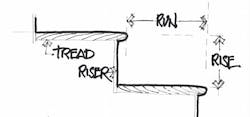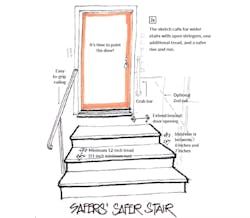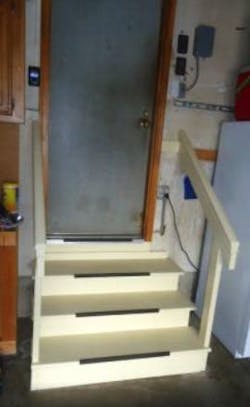A Lesson in Universal Design: How to Make Stairs Safer for All
Photos & sketches: Doug Walter
One of the most dangerous stairs people encounter each day are the ones leading into the house from the garage. Often these are cheap, prebuilt MDF stairs that are narrow, steep, and a hazard to everyone: toddler, teenager, adult, and senior alike.
Such was the case with the stairs in the 1980s suburban Denver home of Don and Ricki Safer. Ricki took a tumble down them about three months ago; she’s been on crutches ever since and is now facing possible surgery. Her “good” knee is swollen from overuse since she hasn’t been able to bear weight on the injured leg.
The Safers, a fit 70-something couple, have lived in the house for 37 years and never given that stair a second thought. But after the fall, Ricki admitted “the stairs terrified me; I never realized how steep and dangerous they were.”
How Steep Should a Staircase Be?
With just two 9-inch treads and three 8¼-inch risers, they’re plenty steep, a condition all too common in a world where builders pride themselves on how little space they can eat up with stairs. I’ve had more than one project where the carpenters told me, “I can save you a whole tread.” My answer is always an emphatic “No!” Saving space isn’t the goal; saving lives is.
Determining a Staircase's Rise and Run
The International Residential Code 2009 allows up to a 7¾-inch rise and a minimum 10-inch run, with the stipulation that all risers and treads be within ⅜ inch of each other. Not too long ago, code allowed up to an 8¾-inch rise, which requires you to be an Olympic-class athlete to climb the stairs. In my opinion, a 7-inch rise in all stairs (the International Building Code 2009 maximum) would allow people to age in place for years.
Similarly, a 10-inch tread is too short. Big shoes like mine hang over 3 inches on that size tread, and so you get used to walking down with your feet angled to catch more surface. I am a proponent of the IBC 2009 minimum 11-inch tread.
Don Safer is a friend, not a client, and when he told me about Ricki’s fall, I asked him to send me a snapshot of the stairs. That night I sketched an alternative stair and gave him the name of a great remodeler friend, Dave Matthews, of Churchill Construction. Dave promptly had the old stair torn out and a new one built, with three 10¼-inch treads and four 6⅛-inch risers, a far more comfortable stair [2a, below].
Designing Handrails
The old railings were 2-by’s on edge and hard to grip. The new railings use a 2x6 for strength with a grip rail mounted on top. Don says he now uses the railings going up and coming down, even if it’s only to lightly graze his hand on them.
Remodeler Dave Matthews mounted an easy-to-grasp grip rail on top of the 2x6 handrails, added sand to the tread paint to improve traction, and applied contrasting nonslip tape to the nosings to help with visibility.
Wider Is Better for a Stair Remodel
I also suggested extending the width of the stairs on the latch side to recognize the space needed to set down a package while fumbling for keys. A wider stair is also easier to get to from the sides, where a closed stringer is a potential trip hazard. My sketch didn’t call for balusters because you don’t need them until the total rise is 30 inches or more.
I did a similar retrofit upon buying my current home, which was built in 1983. The 6½-inch rise was great, but the treads measured just 9⅜ inches and matched the 32 inch width of the door. I didn’t add another tread, but I had the stairs built wider, extending 5 inches to either side of the door, and with deeper 11¼-inch treads for safety.
As an unexpected housewarming present, my artist daughter, Allison, decided to paint our plain old door and new stair. It is now one of a kind in the neighborhood for both looks and safety. For these, we didn’t add a railing, but we did mount a vertical grab bar, which helps older visitors to get up the stairs. Someday soon, as we near our 70s, we’ll add a handrail.
About the Author

Doug Walter
Doug Walter, of Doug Walter Architects, in Denver, has specialized in residential remodeling for 25 years. He has a long history with Universal Design and aging in place. He helped write the NAHB’s Certified Aging-in-Place Specialist curriculum and holds an ICC Certificate as an Accessibility Inspector.






